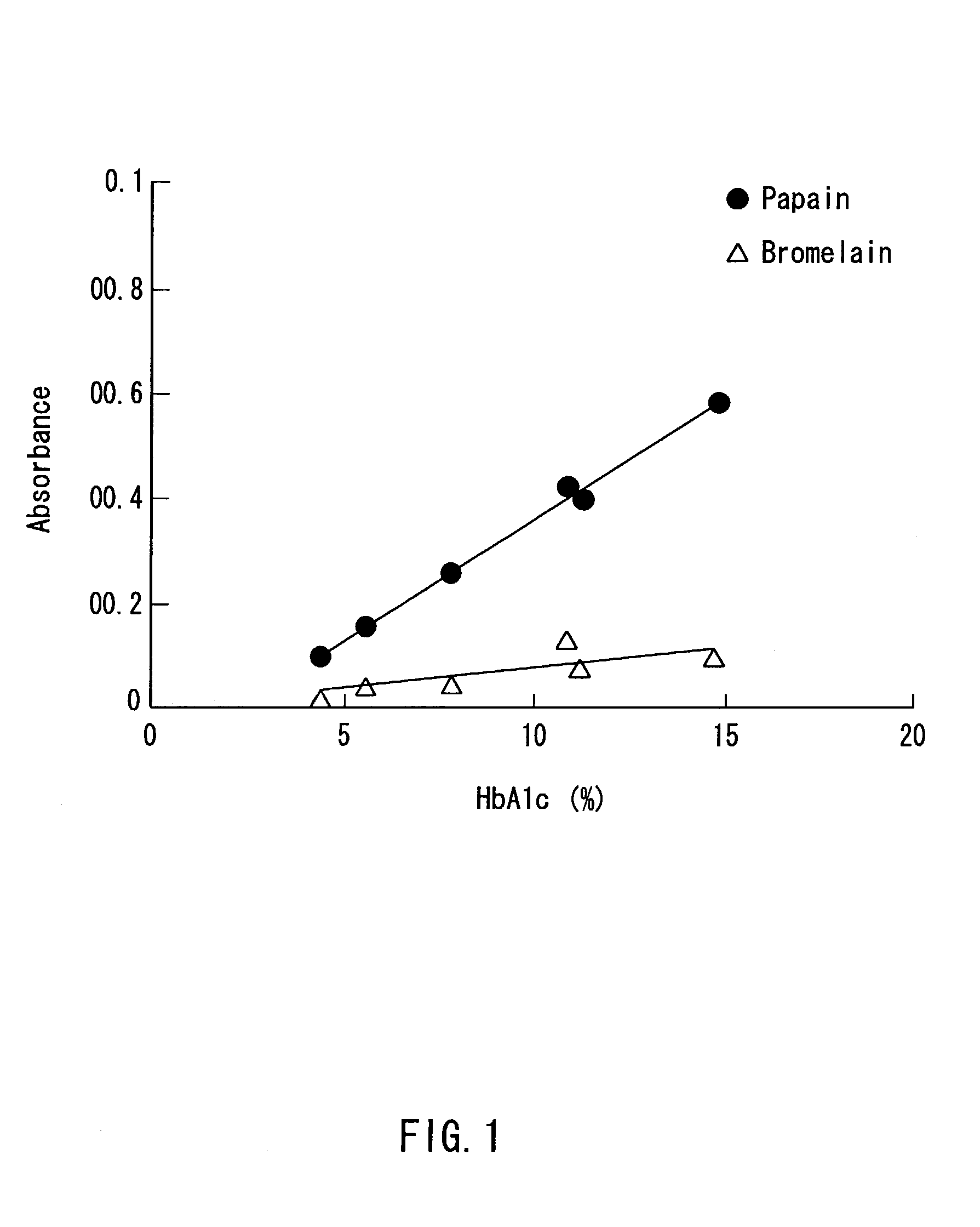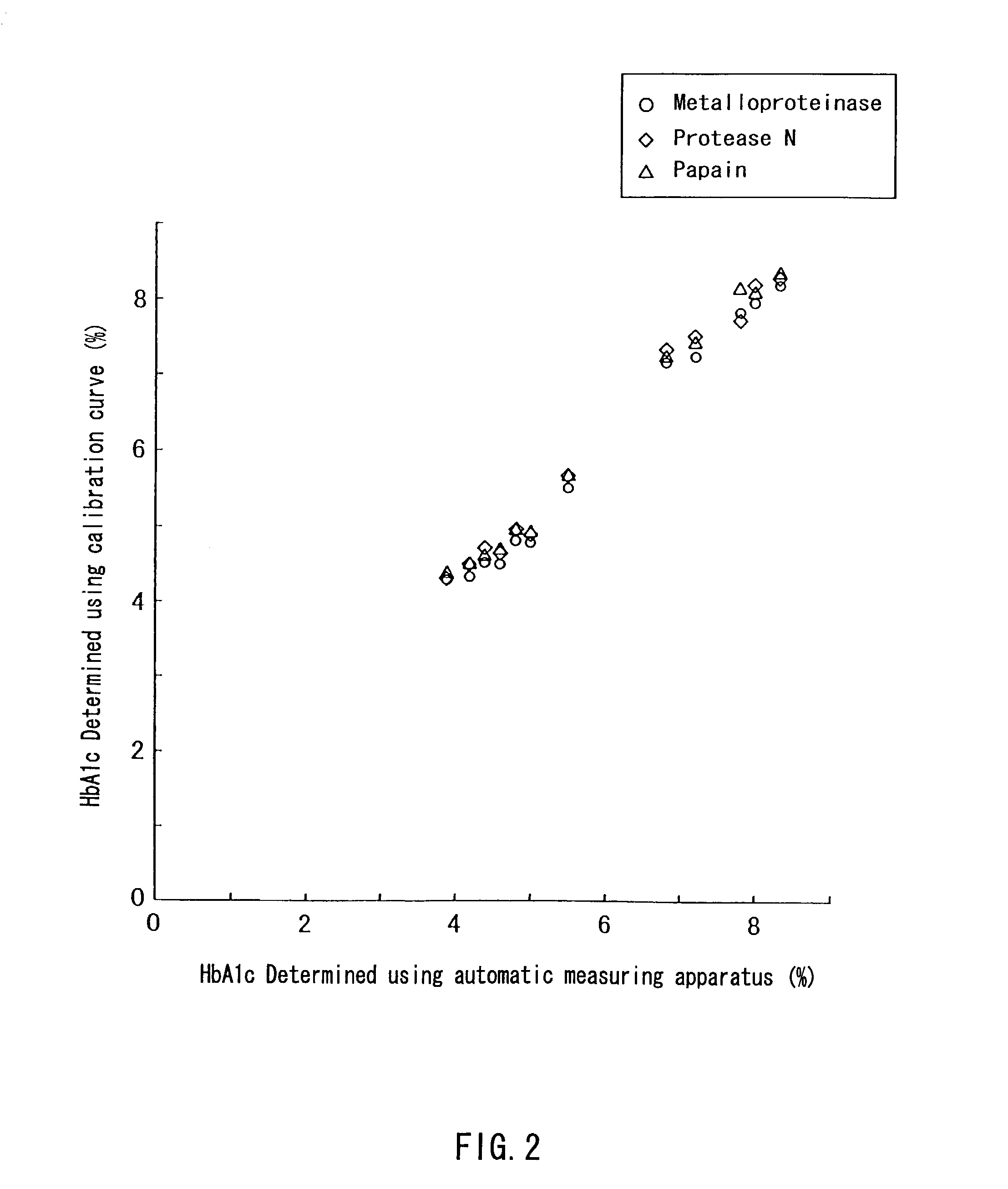Method of selectively determining glycated hemoglobin
a hemoglobin and hemoglobin technology, applied in the field of determining an amount of glycated hemoglobin, can solve the problems of requiring a complicated process for separating plasma and blood cells from whole blood samples, and achieve the effect of removing the effect of other glycoproteins
- Summary
- Abstract
- Description
- Claims
- Application Information
AI Technical Summary
Benefits of technology
Problems solved by technology
Method used
Image
Examples
example 1
[0057]Samples containing glycated hemoglobin and glycated albumin were treated with a papain. Then, a redox reaction thereof was caused by FAOD, and the amount of hydrogen peroxide generated was determined. The samples, reagents, and method used in the determination will be described in the following.
(Samples)
[0058]Human serum albumin with glycation ratio of 22.5%[0059](Sigma Chemical Co.)[0060]Human hemoglobin with glycation ratio of 14%
[0061]The above human hemoglobin sample was prepared in the following manner, and the glycation ratio thereof was determined by HPLC using an ion exchange column.
(Preparation of Human Hemoglobin)
[0062]Whole blood of a healthy subject was centrifuged (1500 G, 10 min) and blood cells were collected. After washing the blood cells with a physiological salt solution several times, a substantially equivalent amount of purified water was added to the blood cells to cause hemolysis. The hemolysate was then centrifuged to remove cell membranes. The solution ...
example 2
[0064]The above-mentioned respective samples (human serum albumin, human hemoglobin) were treated in the same manner as in Example 1 except that 1 mL of a 1g / L bromelain (available from Amano Enzyme Inc., hereinafter the same) was used in place of the papain, and the absorbance thereof was measured in the same manner as in Example 1. The results are shown in Table 1 below.
example 4
(Preparation of Glycated hemoglobin Standard Solutions)
[0077]HbA1c standard reagents (available from SRL, Inc.) were dissolved in purified water to prepare glycated hemoglobin standard solutions containing HbA1c at concentrations 4.3%, 7.8%, 11.2%, and 14.7%, respectively, while containing 10 g / L hemoglobin. Further, HbA1c standard reagents (available from International Regents Corporation) were dissolved in purified water to prepare glycated hemoglobin standard solutions containing HbA1c at concentrations 5.5% and 10.8%, respectively, while containing 10 g / L hemoglobin.
(Preparation of Various Protease Solutions)
[0078]A 2 g / L solution of a bromelain F (available from Amano Enzyme Inc.) and a 1 g / L solution of a papain (available from Hoffmann-La Roche Inc.) were prepared by dissolving the respective proteases in purified water.
(Determining Method)
[0079]First, 0.4 mL of each of the protease solutions and 0.1 mL of a 1.0 mol / L potassium phosphate buffer (pH 8.0) were mixed with 0.5 mL...
PUM
| Property | Measurement | Unit |
|---|---|---|
| temperature | aaaaa | aaaaa |
| concentration | aaaaa | aaaaa |
| concentration | aaaaa | aaaaa |
Abstract
Description
Claims
Application Information
 Login to View More
Login to View More - R&D
- Intellectual Property
- Life Sciences
- Materials
- Tech Scout
- Unparalleled Data Quality
- Higher Quality Content
- 60% Fewer Hallucinations
Browse by: Latest US Patents, China's latest patents, Technical Efficacy Thesaurus, Application Domain, Technology Topic, Popular Technical Reports.
© 2025 PatSnap. All rights reserved.Legal|Privacy policy|Modern Slavery Act Transparency Statement|Sitemap|About US| Contact US: help@patsnap.com


